As cited and cued in the article
Conjuring Eden:
Art and the Entheogenic Vision of Paradise
Entheos: Vol. 1 Issue 1, Summer 2001.
By Carl A.P. Ruck, Blaise D. Staples, Mark Hoffman
Images 31-40
Jump to images 1-10, 11-20,
21-30, 31-40, 41-50
[32] Vision of Ezekiel, with the Ascension
of Christ, miniature, Rabbula Gospels, Biblioteca Medicea-Laurenziana, Florence.
[34] Psalm 148, Narthex dome fresco,
Monastery Church of Koutloumousion, Mount Athos.
[35] Psalm 148, catalogue
of praisers, Narthex dome fresco, Monastery Church of Koutloumousion, Mount
Athos.
[31] Bosch, Temptation panel, Garden
of Delights Detail, Prado, Madrid.
[36] Alabaster bowl, Orphic cultic
initiation, late Roman, collection of J. Hirsch, New York.
[37] Phanes in "egg," Orphic relief,
Museum of Modena.
[38] Ascension mosaic, dome, Hagia
Sophia, Thessalonika.
[39] Empty throne, Italian manuscript
illumination.
[40] Franco Fabbro summary, mushrooms
and snails.
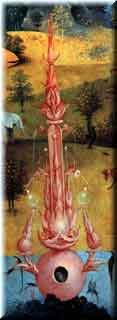
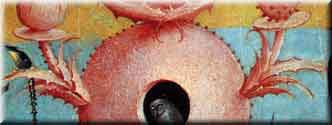
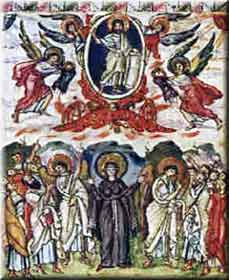
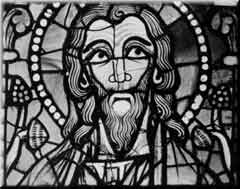
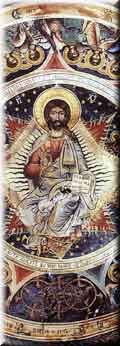
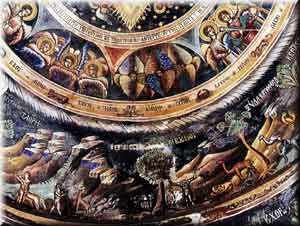
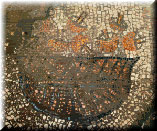
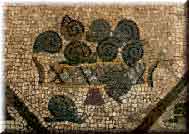
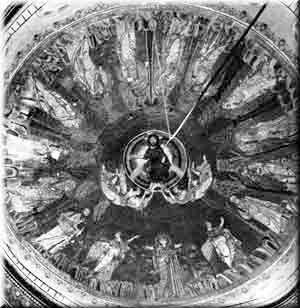
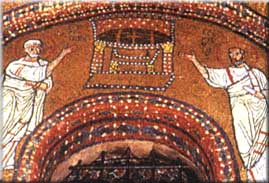
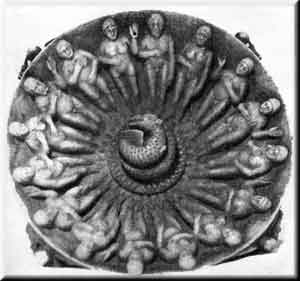
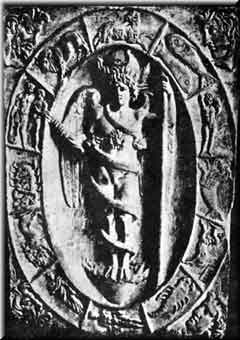


Sumnmary of Fabbro, Franco, "Mushrooms and Snails in Religious Rituals of Early
Christians at Aquileia," Eleusis, n.s. 3, p. 69 sq.
In his wonderful and surprising article, Frank Fabbro documents the depiction
of entheogenic mushrooms, namely Amanita muscaria, in the art of the Christian
Basilica of Aquileia in northern Italy. The section of the mosaic floor which
displays these mushrooms is found in the oratory of the northern hall, which
is the oldest part of the basilica, dating to before 330 AD. An epigraph in
the floor itself claims that the oratory was used for religious ceremonies.
That this mosaic depicts the entheogenic A. muscaria variety of mushroom is
strongly suggested by the fact that there are at least eight exemplars with
dark red caps, scattered with pale orange mosaic tesserae and with radiating
gill-shaped lamellae in the undersurface of the caps. Fabbro is correct in basing
his identification on the surprisingly detailed morphology as represented in
the ancient floor. The fact that medium to large sized red-topped, white shaped
mushrooms appear at all would be enough evidence to prove that early Christians
knew first hand of the entheogenic properties of A. muscaria.
However the careful addition of the scattered pale orange mosaic tesserae‚ can
only be understood in terms of the very distinctive white to golden spots‚ or
warts‚ of the A. muscaria, which distinguish it from other close varieties.
If these scabby remnants of the shattered white universal veil were intentionally
included in the mosaic, as they most certainly were, then the mushroom represented
could be none other than the A. muscaria.
It might be argued that these mushrooms are merely an ornamental element, similar
to that of the other plants and animals rendered in the floor, but this is surely
countered by the fact that the mushrooms are depicted in and around a bowl or
basket, unlike other ornamental motifs. It is difficult to image what artistic
purpose these bowls might serve other than to distinguish their contents as
edible. Fabbro recognizes this fact, and cites other scholars who have argued
that the two bowls suggest the ritual agape feast.
It is extremely fortunate for entheobotanists and students of early Christian
art that the mosaic floor in Aquiela has survived. All too often 'ornamental'
is a term used to describe plants, animals, and symbols whose iconographic significance
is not appreciated nor understood. This ignorance is a consequence of the often
esoteric nature of the icons under consideration.
Another bowl containing snails, probably of the variety Helix cincta. a favored
edible species, is found adjacent to the mushrooms. Fabbro hypothesizes that
the snails and mushrooms were eaten together. It is possible, however, that
snails were allowed to feed on the mushrooms, and then the snails were consumed.
This preparation may have effectively reduced or eliminated the undesirable
physiological effects of consuming the mushrooms directly. This is more likely
than it might sound initially; not only were the Romans well known for snail
breeding, but they recognized that what the snails fed upon had a determining
effect upon their flavor.
Fabbro also mentions that snails, as hibernating animals, are important symbolically
in that they represent death and resurrection. This mythological trait would
certainly not have been lost on the early Christians, whose initiation into
the cult was seen as a death and rebirth. Fabbro cites Brusin, G. & P.L. Zovatto,
Monumenti paleocristiani di Aquileia e di Grado, Doretti, Udine, 1957.
Click
below for the full online article












